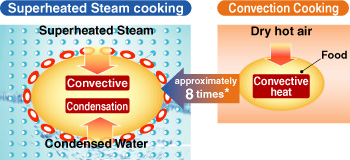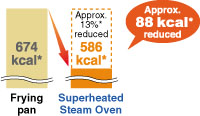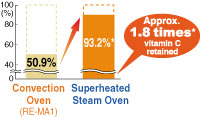| |
|

|
Reduces Calories
A spray of Superheated Steam bathes food, and a massive heat energy eight times* higher than that supplied by a convection heat type oven rapidly reduces the fat content in the food. Calories that are a cause of worry are substantially reduced by simply pushing the button on the Superheated Steam Oven.
e.g. A person walking at 4.0 km/h for 20 minutes expends 60 kcal of energy. (Applies to a person weighing 60 kg. Based on data from the Ministry of Health, Labour and Welfare in Japan.)
Mechanism of reducing fat content
Outflow of fat due to quick temperature rise
(Comparison of energy between Superheated Steam cooking and Convection cooking)

A great amount of heat is delivered to the food at once, so fat within the food reaches its melting point in a brief period of time. The fat liquefies, flows out of the food and drops away.
Quick temperature rise through to the center

|
|
Change of internal temperature of beef when heated at 150°C
|
Since fat is reduced, you can enjoy meat dishes without worry.
• Single portion of steak (200 g)
 |
* Sharp calculations
- Organization contracted to perform analyses: Japan Food research Laboratories. Test report No.: 204070960, July 21, 2004
- Collaboration with Professor Kazutaka Miyatake, Graduate School of Agriculture and Biological Sciences, Osaka Prefecture University.
|
Make crispy and tasty fried chicken without using oil.
• Single portion of fried chicken (125 g)
 |
* Sharp calculations
- Organization contracted to perform analyses: Japan Food Research Laboratories. Test report No.: 204071231, July 29, 2004
- Collaboration with Professor Kazutaka Miyatake, Graduate School of Agriculture and Biological Sciences, Osaka Prefecture University.
|
Reduces Salt
Making use of the natural diffusing action of salt, which causes high salt concentrations to disperse toward lower concentrations, the Superheated Steam triggers such a reaction when it comes into contact with food.
Creating an area of low salt concentration, condensation on the food's surface draws salt out before dripping away, reducing the salt content of food like grilled fish.

* Sharp calculations
- Organization contracted to perform analyses: Japan Food Research Laboratories. Test report No.: 204061300, June 28, 2004
- Collaboration with Professor Kazutaka Miyatake, Graduate School of Agriculture and Biological Sciences and Graduate School of Engineering, Osaka Prefecture University.
Retains Vitamin C
Vitamin C, which is contained in large amounts in vegetables such as pumpkins and broccoli, is a nutrient that is easily broken down by oxidation.
As the cavity of the oven fills with Superheated Steam, it is purged of oxygen, cooking at low oxygen density (less than 3%).
This feature reduces the decomposition of easily oxidized nutrients such as Vitamin C.
Low-oxygen cooking protects food nutrition.

Vitamin C percentage retained
Single portion of grilled vegetables (pumpkin: 75 g)
 |
* Sharp calculations
- Organization contracted to perform analyses:
Japan Food Research Laboratories. Test report No.: 204061469, June
25, 2004
- Collaboration with Professor Kazutaka Miyatake, Graduate School of Agriculture and Biological Sciences, Osaka Prefecture University.
|
Vitamin C percentage retained
Single portion of boiled vegetables (broccoli: 50 g)
 |
* Sharp calculations
- Organization contracted to perform analyses: Japan Food Research Laboratories. Test report No.: 204071667, July 29, 2004
- Collaboration with Professor Kazutaka Miyatake, Graduate School of Agriculture and Biological Sciences, Osaka Prefecture University.
|
|
|